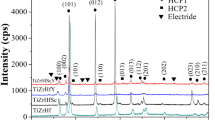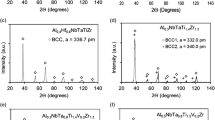Abstract
The thermal stability of a fine-grained aluminum wire made of Al–Mg–Zr–Sc(Yb) alloys with different zirconium and scandium (ytterbium) contents is studied. Samples are produced by induction casting and subsequent cold working by drawing. The structure and properties of fine-grained the Al–0.6Mg–Zr–Sc alloys are shown to exhibit high thermal stability due to preliminary (before drawing) annealing at 320°C for 2 h, resulting in the precipitation of intermetallic Al3(ScxZr1 – x) particles. A fine-grained homogeneous structure with an average grain size of 2.4–2.8 μm and a microhardness of 405–440 MPa is found to be retained in the Al–0.6Mg–Zr–Sc alloys after prolonged annealing at 400°C for 100 h. A fine-grained magnesium-free Al–0.33Zr–0.16Yb ytterbium alloy has a low hardness and low thermal stability. The average grain size in it after annealing at 400°C for 100 h is 4.1–4.8 μm.










Similar content being viewed by others
Notes
The results presented in [26–30] show a pronounced positive effect of ytterbium on the thermal stability of Al–Zr alloys owing to the formation of Al3(Zr,Yb) particles with a growth rate (coalescence), which is lower than that of Al3Zr and Al3Sc particles with an L12 structure. According to [27], this is due to their unique “core–shell” structure, in which a Al3Zr core is surrounded by a Al3Yb shell.
This result indicates, in our opinion, that there is no definite correlation between the ultimate tensile strength and the microhardness in the investigated aluminum alloys. The correlation is often described by ratio σu = HV0.5∕k, where k is the numerical coefficient and k ≈ 3.
The calculation was carried out assuming that Al3(ScxZr1 – x) particles precipitate during the annealing, and the solubility limit of scandium and zirconium in aluminum at 320°C is zero.
REFERENCES
V. I. Elagin, Alloying of Deformable Aluminum Alloys with Transitional Metals (Metallurgiya, Moscow, 1975).
J. Royset and N. Ryum, “Scandium in aluminum alloys,” Intern. Mater. Rev. 50 (1), 19–44 (2005).
Yu. A. Filatov, V. I. Elagin, and V. V. Zakharov, “New Al–Mg–Sc alloys,” Mater. Sci. Eng. A 280 (1), 97–101 (2000).
V. G. Davydov, T. D. Rostova, V. V. Zakharov, Yu. A. Filatov, and V. I. Elagin, “Scientific principles of making an alloying of scandium to aluminium alloys,” Mater. Sci. Eng. A 280 (1), 30–36 (2000).
V. I. Elagin, V. V. Zakharov, and T. D. Rostova, “Scandium-alloyed aluminum alloys,” Metalloved. Term. Obrab. Met., No. 1, 24 (1992).
V. V. Zakharov, “Influence of scandium on the structure and properties of aluminum alloys,” Metalloved. Term. Obrab. Met., No. 7, 7–15 (2003).
V. V. Zakharov, V. I. Elagin, T. D. Rostova, and Yu. A. Filatov, “Metallurgical principles of scandium alloying of aluminium alloys,” Tekhnol. Legk. Splavov, No. 1, 67–73 (2010).
V. V. Zakharov, “Alloying of aluminum alloys with transitional metals,” Tekhnol. Legk. Splavov, No. 1, 22–28 (2011).
V. I. Elagin, V. V. Zakharov, and T. D. Rostova, “Some peculiarities of scandium solid solution decomposition in aluminum,” Metalloved. Term. Obrab. Met., No. 7, 57 (1983).
V. V. Zakharov and T. D. Rostova, “Effect of scandium, transition metals, and impurities on the hardening of aluminium alloys during solid solution decomposition,” Metalloved. Term. Obrab. Met., No. 9 (627), 12–19 (2007).
V. V. Zakharov, “On joint alloying of aluminum alloys with scandium and zirconium,” Metalloved. Term. Obrab. Met., No. 6 (708), 3–8 (2014).
V. V. Zakharov, “Prospects for creating aluminum alloys that are sparingly alloyed with scandium,” Metalloved. Term. Obrab. Met., No. 3 (753), 40–44 (2018).
A. V. Mikhaylovskaya, A. G. Mochugovskiy, V. S. Levchenko, N. Yu. Tabachkova, W. Mufalo, and V. K. Portnoy, “Precipitation behavior of L12 Al3Zr phase in Al–Mg–Zr alloy,” Mater. Charact. 139, 30–37 (2018).
N. E. Hamilton and M. Ferry, “Grain growth in a nanocrystalline Al–Sc alloy,” Mater. Trans. 45 (7), 2264–2271 (2004).
V. Ocenasek and M. Slamova, “Resistance to recrystallization due to Sc and Zr addition to Al–Mg alloys,” Mater. Charact. 47 (2), 157–162 (2001).
Y. W. Riddle and T. H. Sanders, Jr., “A study of coarsening, recrystallization, and morphology of microstructure in Al–Sc–(Zr)–(Mg) alloys,” Met. Mater. Trans. A 35 (1), 341–350 (2004).
M. J. Jones and F. J. Humphreys, “Interaction of recrystallization and precipitation: the effect of Al3Sc on the recrystallization behaviour of deformed aluminum,” Acta. Mater. 51 (8), 2149–2159 (2003).
V. N. Chuvil’deev, A. V. Nokhrin, I. M. Makarov, Yu. G. Lopatin, N. V. Sakharov, N. V. Melekhin, A. V. Piskunov, E. S. Smirnova, and V. I. Kopylov, “Solid solution decomposition mechanisms in cast and microcrystalline Al–Sc alloys: I. Experimental studies,” Rus. Met. (Metally), No. 5, 415–427 (2012).
S. V. Dobatkin, V. V. Zakharov, A. Yu. Vinogradov, K. Kitagawa, N. A. Krasil’nikov, T. D. Rostova, and E. N. Bastarash, “Nanocrystalline structure formation in Al–Mg–Sc alloys during severe plastic deformation,” Rus. Met. (Metally) 2006, 533–540 (2006).
J. M. Martin, Micromechanisms in Particle-Hardened Alloys (Cambridge University, Cambridge, 1980).
T. Fujita, Z. Horita, and T. G. Langdon, “Characteristics of diffusion in Al–Mg alloys with ultrafine grain sizes,” Phil. Mag. A 82 (11), 2249–2262 (2002).
S. P. Wen, K. Y. Gao, Y. Li, H. Huang, and Z. R. Nie, “Synergetic effect of Er and Zr on the precipitation hardening of Al–Er–Zr alloy,” Scr. Mater. 65 (7), 592–595 (2011).
H. Wu, S. P. Wen, K. Y. Gao, H. Huang, W. Wang, and Z. R. Nie, “Effect of Er on the precipitation strengthening of Al–Hf alloys,” Scr. Mater. 87, 5–8 (2014).
A. V. Pozdniakov, R. Yu. Barkov, A. S. Prosviryakov, A. Yu. Churyumov, I. S. Golovin, and V. S. Zolotorevskiy, “Effect of Zr on the microstructure, recrystallization behavior, mechanical properties and electrical conductivity of the novel Al–Er–Y alloy,” J. Alloys. Comp. 765, 1–6 (2018).
A. V. Pozdnyakov, A. A. Osipenkova, D. A. Popov, S. V. Makhov, and V. I. Napalkov, “Effect of small additions of Y, Sm, Cd, Hf, and Er on the structure and hardness of Al–0.2% Zr–0.1% Sc alloys,” Metalloved. Term. Obrab. Met., No. 9 (735), 25–30 (2016).
L. Fang, Z. Zhang, H. Ch. Fang, L. P. Huang, and K. H. Chen, “Effect of Si additions on the precipitation evolution of dilute Al–Zr–Yb alloys,” Mater. Charact. 152, 130–133 (2019).
G. Peng, K. Chen, H. Fang, and S. Chen, “A study of nanoscale Al3(Zr,Yb) dispersoids structure and thermal stability in Al–Zr–Yb alloy,” Mater. Sci. Eng. A 535, 311–315 (2012).
M. E. Dalen, T. Gyger, D. C. Dunand, and D. N. Seidman, “Effect of Yb and Zr microalloying additions on the microstructure and mechanical properties of dilute Al–Sc alloys,” Acta Mater. 59, 7615–7626 (2011).
S. P. Wen, K. Y. Gao, H. Huang, W. Wang, and Z. R. Nie, “Role of Yb and Si on the precipitation hardening and recrystallization of dilute Al–Zr alloys,” J. Alloys Compd. 599, 65–70 (2014).
Y. Zhang, W. Zhou, H. Gao, Y. Han, K. Wang, J. Wang, B. Sun, S. Gu, and W. You, “Precipitation evolution of Al–Zr–Yb alloys during isochronal aging,” Scr. Mater. 69, 477–480 (2013).
G. K. Williamson and W. H. Hall, “X-ray line broadening from aluminium and wolfram,” Acta Metall. 1 (1), 22–31 (1953).
Y. Harada and D. C. Dunand, “Microstructure of Al3Sc with ternary transition-metal additions,” Mater. Sci. Eng. A 329–331, 686–695 (2002).
Y. Harada and D.C. Dunand, “Microstructure of Al3Sc with ternary rare-earth additions,” Intermetallics 17 (1–2), 17–24 (2009).
V. N. Chuvil’deev, A. V. Nokhrin, E. S. Smirnova, and V. I. Kopylov, “Solid solution decomposition mechanisms in cast and microcrystalline Al–Sc alloys: III. Analysis of experimental data,” Rus. Met. (Metally), No. 11, 985–993 (2012).
O. A. Shmatko and Yu. V. Usov, Structure and Properties of Metals and Alloys. Electrical and Magnetic Properties of Metals: A Handbook (Naukova Dumka, Kiev, 1987).
Y. Zhang, K. Gao, Sh. Wen, H. Huang, W. Wang, Zh. Zhu, Z. Nie, and D. Zhou, “Determination of Er and Yb solvuses and trialuminide nucleation in Al–Er and Al–Yb alloys,” J. Alloys Compd. 590, 526–534 (2014).
V. N. Chuvil’deev, E. S. Smirnova, and V. I. Kopylov, “Solid solution decomposition mechanisms in cast and microcrystalline Al–Sc alloys: II. Model for the decomposition of a solid solution during the formation of coherent second-phase particles,” Rus. Met. (Metally), No. 7, 612–624 (2012).
V. V. Zakharov, “Characteristics of the solidification of scandium-alloyed aluminium alloys,” Metalloved. Term. Obrab. Met. 675 (9), 12–18 (2011).
Phase Diagrams of Binary Metallic Systems: A Handbook, Ed. by N. P. Lyakishev (Mashinostroenie, Moscow, 1996), Vol. 1.
M. Furukawa, Y. Iwahashi, Z. Horita, M. Nemoto, N. K. Tsenev, R. Z. Valiev, and T. G. Langdon, “Structural evolution and the Hall–Petch relation in an Al–Mg–Li–Zr alloy with ultra-fine grain size,” Acta Mater. 45 (11), 4751–4752 (1997).
ACKNOWLEDGMENTS
We thank V.V. Zakharov (AO VILS, Moscow) for his recommendations regarding the choice of casting and preliminary aging conditions for the aluminum alloys.
Funding
This work was supported by the Russian Scientific Foundation (project no. 18-13-00306).
Author information
Authors and Affiliations
Corresponding author
Additional information
Translated by T. Gapontseva
Rights and permissions
About this article
Cite this article
Chuvil’deev, V.N., Nokhrin, A.V., Shadrina, Y.S. et al. Thermal Stability of the Structure and Mechanical Properties of Fine-Grained Aluminum Conductor Alloys Al–Mg–Zr–Sc(Yb). Russ. Metall. 2020, 987–998 (2020). https://doi.org/10.1134/S0036029520090037
Received:
Revised:
Accepted:
Published:
Issue Date:
DOI: https://doi.org/10.1134/S0036029520090037




